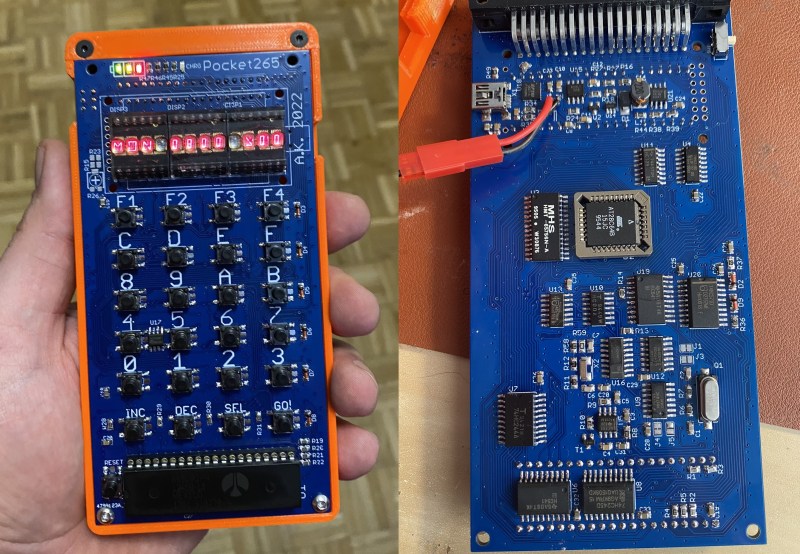Single-board computers have been around ever since microprocessors became affordable in the 1970s and never went away. Today we have Raspberry Pis and LattePandas, while back in the ’70s and ’80s there were the Ferguson Big Board, the KIM-1 and a whole array of Intel SDK boards. Although functionally similar to their modern counterparts with a CPU, RAM, ROM and some basic peripherals, the old boards were huge compared to today’s tiny platforms and typically required a rather beefy power supply to operate.
It doesn’t have to be that way though, as [Aleksander] shows with the Pocket265: a handheld 6502 single-board computer somewhat reminiscent of the famous KIM-1. Like that classic machine, it’s got a hexadecimal keypad to enter programs using machine code and a row of LED displays to show the programs’ output. Unlike the KIM, the Pocket265 is small enough to hold in one hand and uses bubble LED displays, which make it look more like a programmable calculator from the 1970s. It comes with a lithium battery that makes it truly portable, as well as a sleek 3D printed case to make it more comfortable to hold than a bare circuit board.
The single ROM chip contains a monitor program that runs the basic user interface. It also makes programming a bit less tedious by implementing a number of system calls to handle things like user input and display output. A serial EEPROM enables local data storage, while a UART with a USB interface enables data transfer to other computers. If you’re interested in building and programming such a machine yourself, [Aleksander] helpfully provides code examples as well as full hardware documentation on his GitHub page.
The 6502 remains a firm favorite among hardware hackers: some projects we recently featured with this CPU include one beautifully made machine, this easy-to-build single-board computer and this huge breadboard-based contraption. Looking for something smaller? Try this tidy little board or this 6502 coupled to an FPGA.

















In 1980, someone I knew had a terminal the size of a calculator. I think LED display. He used it to configure Intersil 6100 boards he was manufacturing to sell to a record plant to modernize their operation.
you had me at DL1414.
I annoyed my employer and college profs in the 80’s by designing in those magnificently beautiful things.
I still have a few on-hand. They’re so expensive now; I should have hoarded more.
I got mine from some electronic scrap I bought years ago, but these are now available on Ali somewhat cheap. I bought some from there, look legit
I have kind of wished that narrower ones were available like what I show in the middle of the page at http://wilsonminesco.com/6502primer/displays.html . For a much, much higher price, you can get the narrow size in a serial-interfaced dot-matrix display from Broadcom, so you can display upper- and lower-case and all the special characters (even your own custom ones) that will fit in a 5×7 matrix for each character position. I have a couple of samples here. See https://www.broadcom.com/products/leds-and-displays/smart-alphanumeric-displays/serial-interface
Thanks for the links.
I wonder if those displays could be used in repairing old HP calculators.
You’d have to add a microcontroller to read the continually strobed digit & segment signals and translate them into a dot pattern and feed them serially into the Broadcom display. It could be done, but it would be quite a project. BTW, these displays have a serial in _and_ out so they can be daisychained. Mechanically they are also end-to-end stackable, so you can get as many characters as you want (or can afford, LOL).
I can play Loderunner and Turtle Graphic again
But will this thing run VisiCalc?
why not normal lipo socket on board? WHY!!!
very good idea, but computer need power, specific small computer!
P.S. and in my opinion rotor similar old pdp11
I agree, I wanted lipo socket too. There is a 2-pin JST socket in the project, but due to slight miscalculation it doesn’t fit. Welp, it’s a first prototype, something had to go wrong :)
Ahhh, HPDL141s. Love to see these vintage LED display.
This brings back memories: I learnt programming on a KIM-1 in my first job back in ’79
Now you have me itching for a calculator style interface board. Keys, display, and power regulation (power rails, battery monitor & recharge).
Leaving CPU, RAM, and other peripherals on a SBC that sits below. Portable, modifiable, versatile.